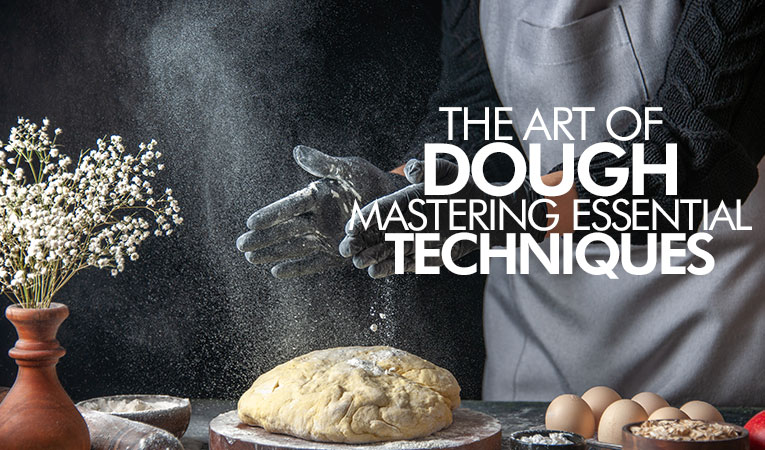The Art of Dough: Mastering Essential Techniques for Perfect Baking
22-06-2023

Are you ready to take your baking skills to the next level? Join us as we dive into the wonderful world of dough in baking. From flaky pastries to fluffy breads, mastering the art of dough is essential for creating mouthwatering treats that will impress everyone.
In this comprehensive guide, we'll explore the different types of dough, uncover the secrets to successful mixing and kneading, and understand the role of yeast and proofing. We'll also troubleshoot common dough issues and teach you how to shape and form dough like a pro.
With step-by-step instructions and helpful tips, you'll gain the confidence to tackle any dough recipe. Get ready to embark on a delicious journey filled with the aroma of freshly baked goods and the joy of creating something extraordinary from scratch.
So grab your apron, dust off your rolling pin, and let's dive into the art of dough together. It's time to elevate your baking game and indulge in the satisfaction of mastering the perfect dough for all your sweet and savory creations.
Understanding Different Types of Dough
Dough is a versatile component in baking, and different types of dough yield distinct results in terms of texture, flavor, and purpose. In this section, we will explore various types of dough, including pastry dough, bread dough, and cookie dough, and understand their unique characteristics and uses. We will also delve into the key ingredients that contribute to the success of each dough recipe.
- Pastry Dough: Pastry dough is a delicate and flaky dough commonly used in desserts and pastries. It is made by combining flour, fat (such as butter or shortening), and water. The fat is cut into the flour to create a crumbly texture, which transforms into layers of flakiness during baking. Pastry dough is commonly used for tarts, pies, and turnovers.
- Bread Dough: Bread dough is the foundation of various bread recipes, including loaves, rolls, and buns. It typically consists of flour, water, yeast, and salt. The yeast provides leavening, causing the dough to rise and create a light and airy texture. Bread dough requires kneading to develop gluten, which gives the bread its structure and chewiness. It is versatile and can be shaped into different forms.
- Cookie Dough: Cookie dough is a sweet dough used to make a wide variety of cookies. It typically includes ingredients such as flour, sugar, butter, eggs, and flavorings like vanilla extract. The dough is mixed until the ingredients are evenly combined, resulting in a rich and indulgent treat. Cookie dough can be rolled, dropped, or shaped into specific forms before baking.
- Pie Dough : Pie dough, also known as pie crust, is a simple yet essential element in pie making. Made from flour, fat (such as butter or shortening), liquid (usually water), and salt, this dough is prized for its delicate and flaky texture. The fat is cut into the flour until it resembles coarse crumbs, and the liquid is added gradually to bring the dough together. With proper handling and rolling, pie dough creates a perfect foundation for a variety of sweet and savory pies, adding a deliciously crisp and buttery touch to each bite.
Understanding the unique characteristics of each dough type is crucial for successful baking. Pastry dough, with its delicate and flaky texture, is ideal for creating light and crispy pastries. Bread dough, on the other hand, provides the structure and softness necessary for delicious bread loaves and rolls. Cookie dough allows for endless creativity in shaping and decorating cookies, resulting in delightful treats.
Mixing and Kneading Techniques
Proper mixing and kneading techniques play a crucial role in the success of your dough, as they contribute to the development of gluten, which provides structure and elasticity. In this section, we will explore the importance of mixing and kneading, different methods for mixing, and essential tips to achieve the perfect consistency and texture in your dough. We will also highlight common mistakes to avoid during the mixing and kneading process.
- Developing Gluten: Gluten is a protein found in wheat flour that gives dough its elasticity and helps it rise. Proper mixing and kneading promote the development of gluten strands, which create the desired structure in bread and other baked goods. When mixed with liquid, the proteins in the flour form gluten, resulting in a stretchy and elastic dough.
- Mixing Methods: There are several methods for mixing dough, depending on the recipe and equipment available:
- Hand Mixing: This traditional method involves combining the ingredients by hand, using a wooden spoon or your fingertips. It allows you to have better control over the dough's consistency and texture.
- Stand Mixer: A stand mixer with a dough hook attachment is a convenient tool for mixing and kneading dough. It saves time and effort, especially when working with larger batches or tougher dough.
- Food Processor: Some dough recipes can be prepared using a food processor with a dough blade. This method helps in quickly mixing the ingredients and developing gluten.
- Achieving the Right Consistency and Texture: To achieve the perfect dough consistency and texture, consider the following tips:
- Measure ingredients accurately to maintain the proper ratio and balance in the dough.
- Gradually add liquid to the dry ingredients, mixing as you go, until the dough comes together. Avoid adding all the liquid at once, as it may lead to a sticky or overly wet dough.
- Adjust the amount of flour or liquid as needed to achieve the desired consistency. The dough should be soft, slightly tacky, and easily pliable.
- Common Mistakes to Avoid: While working with dough, it's essential to avoid common mistakes that can affect the final result:
- Overmixing: Overmixing the dough can lead to excessive gluten development, resulting in a tough and dense texture. Mix the dough until the ingredients are just combined.
- Adding too much flour: Adding excessive flour can make the dough dry and stiff. Add flour gradually and only as needed to prevent this.
- Kneading too aggressively: Kneading the dough too forcefully can overdevelop gluten and make the final product tough. Knead gently until the dough becomes smooth and elastic.
By mastering the art of mixing and kneading, you can ensure a well-developed gluten network, resulting in light and airy baked goods. The right mixing method, proper consistency, and avoiding common mistakes will help you achieve the desired texture and quality in your dough. In the next section, we will explore the essential techniques for proofing and shaping dough, taking your baking skills to the next level. So, let's continue our journey toward becoming dough experts!
The Role of Yeast and Understanding Proofing
Yeast plays a vital role in bread and other yeast-based doughs, contributing to their flavor, texture, and rise. In this section, we will delve into the significance of yeast, explore different types of yeast, discuss the process of proofing, and provide essential tips for successful yeast activation and proofing.
- The Role of Yeast: Yeast is a microorganism that feeds on sugars and produces carbon dioxide gas through fermentation. This gas gets trapped in the dough, causing it to rise and create a light and airy texture in the baked goods. Yeast also adds a distinctive flavor and aroma to bread.
- Types of Yeast: There are various types of yeast available for baking, including:
- Active Dry Yeast: This is the most common type of yeast found in stores. It needs to be dissolved in warm water before use to activate it.
- Instant Yeast: Also known as rapid-rise or quick-rise yeast, it can be added directly to the dry ingredients without prior activation. It provides faster fermentation and shorter proofing times.
- Fresh Yeast: Also called cake yeast or compressed yeast, it comes in a solid block or cake form. It needs to be crumbled or dissolved in liquid before use.
- Understanding Proofing: Proofing is the process of allowing the dough to rise after it has been shaped. During proofing, yeast ferments the dough, producing carbon dioxide gas, which causes it to expand and develop flavor. The proofing time can vary depending on factors such as the ambient temperature and the type of yeast used.
- Impact on Flavor and Texture: Proper proofing significantly affects the flavor and texture of the final product. Underproofed dough may result in a dense and doughy texture, while overproofing can cause the dough to collapse or develop a yeasty or sour taste. It's crucial to find the right balance and proof the dough until it has doubled in size and is soft and pillowy.
- Tips for Successful Yeast Activation and Proofing: To ensure successful yeast activation and proofing, keep the following tips in mind:
- Activate the yeast: If using active dry yeast, dissolve it in warm water with a small amount of sugar. The water should be around 105°F to 110°F (40°C to 43°C). Let it sit for a few minutes until it becomes frothy, indicating that the yeast is active.
- Provide the right environment: Choose a warm, draft-free area for proofing. If the room is too cold, the dough will take longer to rise. You can also use a lightly greased bowl and cover it with a damp cloth or plastic wrap to create a humid environment.
- Keep an eye on the dough: Check the dough periodically during proofing to ensure it doesn't overproof. Gently press a finger into the dough, and if it slowly springs back, it is ready for the next step.
Understanding the role of yeast and mastering the proofing process will help you achieve flavorful, well-risen baked goods. In the next section, we will explore the art of shaping dough, providing you with essential techniques to create beautiful and professional-looking baked treats. Let's continue our journey toward becoming dough experts!
Troubleshooting Dough Issues
Even the most experienced bakers encounter dough-related challenges from time to time. In this section, we will address common issues that can arise during the dough-making process and provide practical solutions to overcome them. By understanding how to troubleshoot dough problems, you'll be better equipped to achieve excellent results every time.
- Dryness, Stickiness, and Lack of Rise: Dry dough can result in dense and crumbly baked goods, while overly sticky dough can be challenging to work with. Additionally, if your dough fails to rise properly, it may lead to flat and heavy baked goods. To troubleshoot these issues:
- Dryness: Add small amounts of liquid, such as water or milk, gradually to the dough until it reaches the desired consistency. Avoid adding too much liquid at once to prevent making the dough too wet.
- Stickiness: Incorporate more flour, a little at a time, to reduce stickiness. Knead the dough thoroughly until it becomes smoother and less tacky.
- Lack of Rise: Ensure that the yeast is fresh and properly activated. Check the proofing conditions, ensuring a warm and draft-free environment. Give the dough enough time to rise until it doubles in size.
- Underproofed or Overproofed Dough: Proper proofing is essential for achieving optimal texture and flavor in your baked goods. If your dough is underproofed or overproofed, try the following solutions:
- Underproofed Dough: Extend the proofing time by allowing the dough to rise longer. Keep in mind that proofing times can vary depending on temperature, so be patient and wait until the dough has properly risen.
- Overproofed Dough: If your dough has risen excessively and is starting to collapse, gently deflate it and reshape it. Reduce the proofing time for future batches to avoid overproofing.
- Adjusting Dough Consistency and Hydration: Dough consistency and hydration levels can greatly affect the final texture of your baked goods. If your dough feels too dry or too wet, consider these adjustments:
- Dry Dough: Add small amounts of liquid, such as water or milk, to moisten the dough and achieve the desired consistency.
- Wet Dough: Incorporate additional flour gradually until the dough becomes less sticky and more manageable.
Remember to make adjustments gradually, as adding too much liquid or flour at once can drastically alter the dough's texture and consistency.
Shaping and Forming Dough
The art of shaping and forming dough allows you to transform it into various appealing and creative forms. In this section, we will explore different techniques for shaping dough and enhancing its visual appeal. Whether you're making rolls, braids, or bread loaves, these tips will help you achieve beautifully shaped and professional-looking baked treats.
- Shaping Techniques: Mastering the art of shaping dough opens up a world of possibilities. Here are some techniques to try:
- Rolls: Roll the dough into smooth balls, ensuring they are evenly sized for consistent baking.
- Braids and Twists: Divide the dough into equal portions and weave or twist them together to create intricate patterns.
- Decorative Designs and Patterns: Elevate the visual appeal of your baked goods by incorporating decorative designs and patterns on the dough's surface. Consider using a sharp knife or dough scraper to make cuts or designs that will expand during baking, creating an eye-catching finished product.
- Scoring Techniques for Bread Dough: Scoring bread dough allows steam to escape during baking, resulting in a controlled expansion and an attractive crust. Experiment with different scoring patterns, such as straight lines, diagonal cuts, or decorative shapes, to achieve the desired aesthetic.
By mastering the art of shaping and forming dough, you'll be able to create visually stunning baked treats that are as delightful to the eye as they are to the palate. In the next section, we will focus on the final steps of the baking process, including baking temperatures, times, and the essential art of knowing when your dough is perfectly baked.
Proper Dough Handling and Storage
Proper dough handling and storage are crucial steps in achieving the best possible results in your baked goods. In this section, we will explore the best practices for handling dough to prevent excessive gluten development and discuss the various methods for storing dough to maintain its quality.
- Handling Dough to Prevent Excessive Gluten Development: Gluten, a protein formed when flour comes into contact with liquid, gives bread and other baked goods their structure and texture. However, overmixing or over-kneading dough can lead to excessive gluten development, resulting in a tough and chewy final product. To handle dough properly:
- Mix and knead the dough just until the ingredients are fully combined and a smooth texture is achieved. Avoid overmixing or overworking the dough.
- Use the windowpane test: Take a small portion of the dough and gently stretch it. If it forms a thin, translucent membrane without tearing, it has reached the desired gluten development.
- Allow the dough to rest for a few minutes between mixing and kneading stages. This allows the gluten to relax and makes the dough easier to work with.
- Proper Dough Storage: Properly storing dough is essential for maintaining its quality and freshness. Here are some tips for dough storage:
- Refrigeration: If you're not planning to bake the dough immediately, refrigerate it in a covered container or wrapped in plastic wrap. This slows down the fermentation process and extends the dough's shelf life. Note that refrigerated dough may require additional proofing time before baking.
- Freezing: Dough can also be frozen for longer storage. Shape the dough into desired forms (e.g., rolls, loaves) and wrap them tightly in plastic wrap or place in airtight containers. Thaw the frozen dough in the refrigerator overnight before proceeding with proofing and baking.
- Temperature and Dough Fermentation: Temperature plays a crucial role in dough fermentation and rising times. Here's what you need to know:
- Fermentation: The process of yeast converting sugars into carbon dioxide and alcohol occurs more rapidly at warmer temperatures. However, warmer temperatures can also lead to faster dough development and potentially compromise the flavor. Find the optimal temperature range for your specific dough recipe to achieve the desired fermentation and flavor profile.
- Rising Times: Rising times can vary depending on the ambient temperature. Warmer temperatures will generally result in faster rising, while cooler temperatures will slow down the process. Keep in mind that longer rising times can contribute to improved flavor development in the dough.
By understanding the impact of temperature on dough fermentation, mastering proper dough handling techniques, and utilizing appropriate storage methods, you'll be well on your way to becoming a skilled baker capable of creating delectable treats with exceptional texture and flavor. In the next section, we will dive into the final stage of the baking process: baking temperatures, times, and the art of achieving the perfect bake.
Conclusion:
We hope this comprehensive guide has inspired you to embark on your journey of mastering the art of dough in baking. By understanding the different types of dough, refining your mixing and kneading techniques, and embracing the magic of yeast and proofing, you now possess the knowledge and skills to create delectable treats with confidence.
Remember, practice and experimentation are key to becoming a dough expert. Don't be discouraged by any setbacks or challenges you may encounter along the way. Embrace them as valuable learning experiences that will only enhance your baking prowess.
Now, armed with this newfound knowledge, it's time to unleash your creativity and explore the endless possibilities of dough. From tender pastries to crusty breads, the world of baking is yours to conquer.
We would love to hear about your baking adventures and see your mouthwatering creations. Share your thoughts, questions, and photos in the comments below. And if there are any specific topics or techniques you'd like us to cover in future blogs, please don't hesitate to let us know.
Thank you for joining us on this dough-filled journey. May your kitchen be filled with the tantalizing aroma of freshly baked delights, and may your baking endeavors continue to bring joy and satisfaction to your culinary pursuits. Happy baking!





